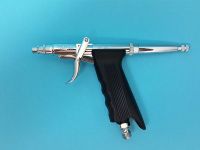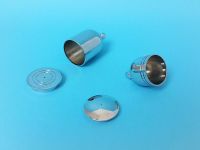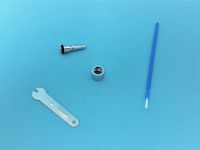Sparmax | GP-35 Airbrush
Reviewed by Mitko Nikitov
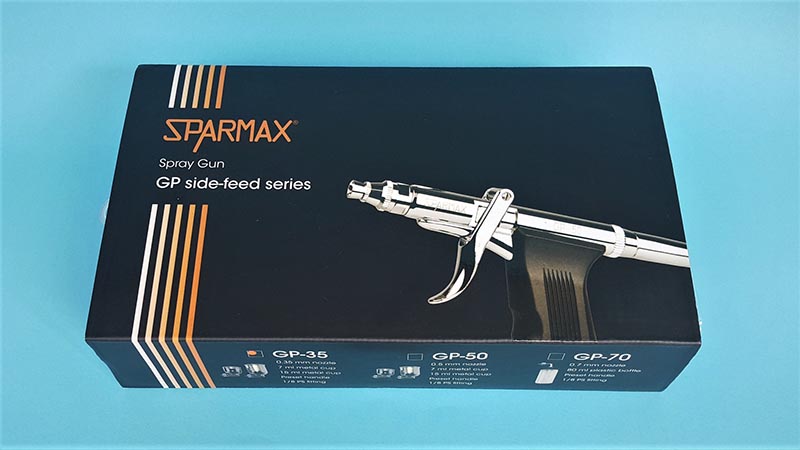
Introduction
Pistol grip airbrushes are not the first thing that you get, when you start researching for airbrushing. Many people learn about them after already bought and used some standard looking airbrush and the reason they start searching for another is that they are not satisfied with the experience.
Pistol-grips are airbrushes that offer more control and are designed mostly based on different concept of ergonomics. They do require less effort when applying tricky and small elements, and at the same time give more relaxed hand while working for a longer airbrushing sessions.
Box
Sparmax GP-35 comes in a plastic clamshell, translucent and with a hanger of one of the sides. It looks similar to their conventional airbrushes boxes, but it is slightly bigger here. Heavier too. The clamshell is wrapped in black cardboard with very shop-friendly appearance.
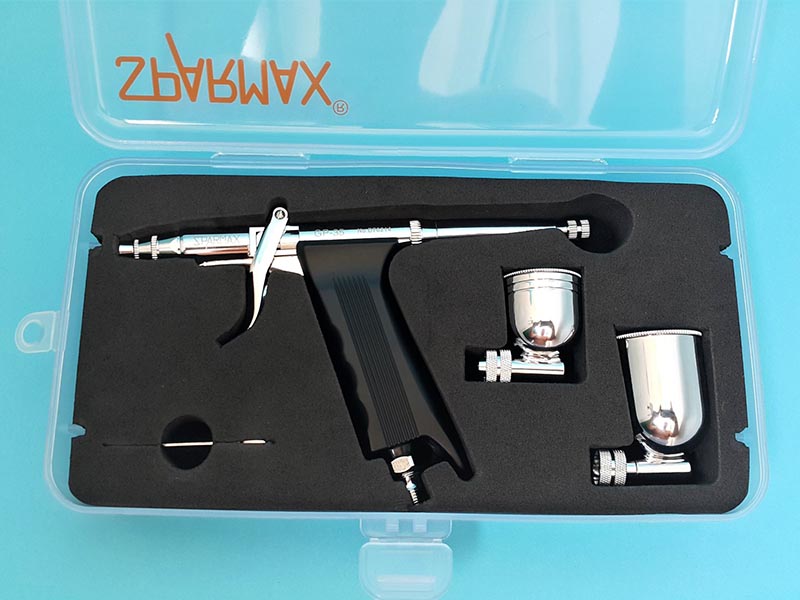
Since GP-35 is part of Sparmax’s Spray Gun Series and not the only one available, we have all the options on the side of the box, with little red dot marking out the contents of that particular setup.
Difference between the three available is mainly the nozzle size. We have .5 for GP-50 and .7 for GP-70. Latter one, offering 80ml plastic bottle instead of the metal cups featured in the other two. In our case, we have .35, which is the first one described.
Contents
First thing besides the pistol airbrush that catches attention are the two color cups included. They are 7ml and 15ml and are designed to be screwed in and tighten to the body of the airbrush. That allows for very good and secure way of keeping your work safe. It is not an isolated case to spill some paint over, when color cup is just a straight metal tube entering your airbrush. Especially with gravity feed cups as those here.
There is also a plastic handle, which isn’t included in all of the pistol grip airbrushes on the market. My first such airbrush required 10% more investment in such an add-on. And it is a vital one.
1/8 connect fitting on the bottom of the handle is standard, but as an add-on, there is a ribbed one, designed to be used with a rubber hose, available in any hardware store offering pneumatic supplies. It is a two-part piece, with rubber seal in case you are using different type of hose. That reminds me more of a car paint shop or auto-body art and maybe that was the idea here.
There is a wrench of course, as well as a blue-handled brush for cleaning purposes. Most of the Sparmax airbrushes that I’ve seen have one in the set, and in case this is your first Sparmax it is a nice add-on to have.
Everything besides the ribbed connector and the brush is securely sitting in a foaming material, holding airbrush tightly so you can hang it on your wall using the clamshell hanger and not worry that you will drop anything accidentally.
Instructions
These aren’t something that I usually mention in the reviews I do. Here though, they are important. Although this is basically dual-action side-feed airbrush, it differs from the conventional airbrushes that we know. In that matter, I would strongly advice to take a closer look at the instructions before you start working with your pistol-grip.
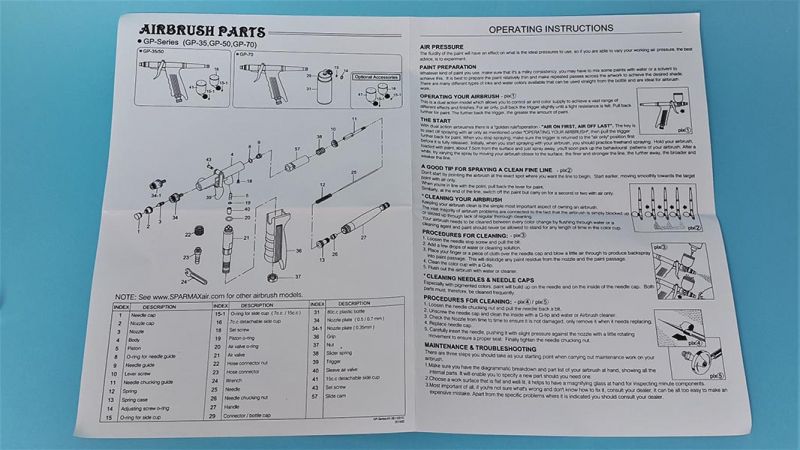
Assembly process isn’t complex but is different. Also, more parts are included in the design and therefore, one must apply more attention while cleaning the disassembled airbrush.
Sparmax feature wonderful explanation in the instruction sheet and you can get a basic idea from the pictures included. Cleaning of this airbrush, according to my experience, require disassembly less often and instead more flushing with higher pressure. Even with that though, at some point you will have to peak inside of the GP-35, so familiarize yourself with the guide how-to.
Testing, Testing, 1,2 3
Swiveling paint cup can be tightened a lot, but since I love to move around, I don’t overdo it, so to adjust constantly while airbrushing. The screw-in procedure might leave you with a feeling that the connection is a bit loose, but that quickly changes after couple of twists.
Trigger works very good, although at first movement might give you a feeling for a quicker reaction than needed. Once loaded though, the GP-35 reacts as expected from a pistol-grip. The first part of the movement shoots air, then the paint comes through.
The handle fits nicely and the grip is good. Heavier airbrush – about 200 grams before the paint in the cup - helps the balance and once you start spraying you quickly forget about the tool itself.
Tail stopper is something that I don’t use often, but for mottling, here it works even better than with the conventional airbrush. The reason for that is, that if you are a master with the conventional airbrush, you can control both: the air quantity and the paint. And, which should go first.
Here, in order to control the air solely, you need to do it through the pressure regulator of the compressor. In order to get the paint going, you must first pull the trigger which will start with the air first and no paint at all for the initial movement.
With the conventional gun, you can pull the trigger for paint, without pressing it, thus – no air at all. And that is where a lot of accidents happen. It seems more controllable, but it is an accident-happy situation.
That is another trouble-excluding feature of the GP-35 and of course, most of the pistol-grip airbrushes. At least in my eyes. There is no way you can get the paint going, without first putting a solid air stream through the nozzle. No drops on the nozzle, no spitting out of nowhere.
Conclusion
In tough times, when everything looks way too hard and risky, I always relied on pistol-grip airbrushes. Before, that was my trusty TR-1, which for a while now has new owner who is walking the same path I did couple of years ago. Now, it is Sparmax GP-35.
Pistol-Grip airbrushes give versatility, which is hardly matched by the conventional airbrushes. Even though you cannot get .15 nozzle, there is more than enough with GP-35 and it will be suitable for fine mottling and free-hand camouflage. Actually, nozzles with that size suit perfectly 90% of the modeling needs. In addition to that, trigger-action gives better control, which adds to that.
Sparmax GP-35 will cope equally with varnish layers, primers and fine lines, and I trust that for large scale applications is one of the best options available on the market. Jets in 32nd scale and props in 24th quite often require work with airbrush that is more closely related to GP-35 instead of using something with .2mm nozzle, where painting, varnishing can be a torture.
Trigger gives precision and control that not everybody can manage using conventional airbrush. Handle allows for more relaxed wrist, intuitive and effortless work. Weight helps balance. In general, pistol-grip airbrushes offer just a bit more than the conventional ones.
Sparmax GP-35 might look big-ish, heavier and more robust than any precision gun out there, but it will take you places where any airbrush can go, and more. The look is deceiving for those that encounter that concept for the first time. I can only recommend you getting one. In my opinion, pistol-grip airbrush is a must for every toolbox of a large scale modeler. With Sparmax’s well-known reliability and affordable prices, GP-35 is a gem!
Check out www.sparmaxair.com for GP series and you will be pleasantly surprised with the prices and please don’t forget to mention for the review and where you learned about them!
© Mitko Nikitov 2017
This review was published on Monday, August 28 2017; Last modified on Friday, September 01 2017

